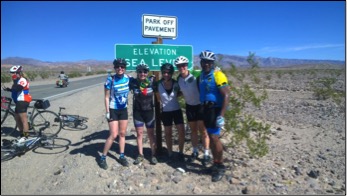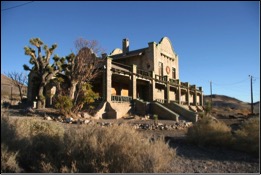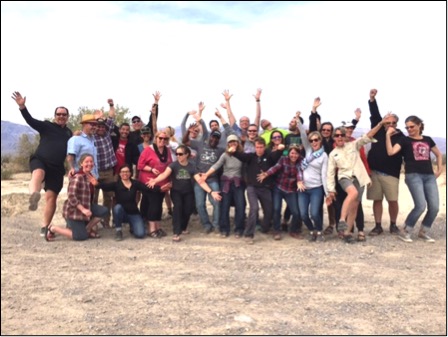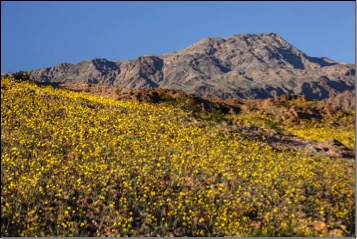In February, thirty individuals participated in Climate Ride’s Death Valley Ride through Death Valley National Park. One of those participants, Kevin Martin, shared with us his recap of his experience in the park.
It almost seems a disservice to call Death Valley a desert. A desert in my mind conjures up images of zero life and miles of nothingness. Death Valley could not be further from that imagery. I have never seen such interesting natural land formations, multi-layered color schemes and a profusion of life in a place where its very name connotes loss and demise. Death Valley, especially in 2016 with its ‘super bloom’, is a place of life and profound imagery in abundance.
The Death Valley Climate Ride I believe was a lot smaller and more intimate than most of their other more popular rides, so it might not be exactly indicative of the others, but I have a feeling the basic formula is the same – pairing cycling routes with unique experiences in the area. This Climate Ride did that consistently throughout our four-day tour.
MEET & GREET THE CLIMATE RIDE CLAN (Day 0 – Stovepipe Wells)
It’s probably not entirely fair to call the group of thirty two individuals I met a clan, but everyone, with the exception of three twenty-something guys who worked at Google (aka the Google Guys) had been on at least one Climate Ride before and seemed to know at least half of the riders and all of the Climate Ride staff. I usually prefer a bit more anonymity than our small gathering allowed. I was certainly an outsider, but felt far from unwelcomed.
After quick introductions we were told the boundaries of our campsite and were asked to find a spot for our tents and to get ready for dinner. Unlike the Complete Sherpa Package I had during the Cycle Greater Yellowstone ride, I was expected to actually set up my own tent. All I can say is tents have come a long way since the days I struggled and repeatedly failed at erecting my tent during my Webelos Scouting days. By peering over at my other fellow campers I was able to get a step by step tutorial without anyone knowing I didn’t have a clue.
I felt like I had a close-up view of the surface of Mars. The mountains and terrain looked like the backdrop of a science fiction movie that was painted too perfectly to be real. And the eye-popping wonderment was just beginning. When the sun was no longer visible on the horizon an abundance of stars made a sudden appearance that seemed so close and so dense I could have been convinced we were in a different solar system. I saw others doing what I was doing, reaching out their hands as if to touch the stars – the same sensation you have when wearing 3-D glasses. To look up at the night sky too long was dizzying and even disorienting, but magnificent all the same. I’ve never considered myself an urban dweller (more of a suburban dweller), but this city/suburban mouse was completely in awe of how black the night sky can become when there are no city lights.

FIRE IN THE KILN! (Day 1 – Stovepipe Wells to Panamint Springs)
We left the campsite in three separate groups. We were asked to self-select which group we thought we would feel the most comfortable in, Group A, B or C, with “A” being the strongest and fastest riders. The groups would leave in 10 minute intervals. I selected Group B, believing my abilities were somewhere in the middle of the pack, but also hoping I could exceed expectations.
The riding pace was quick with nervous energy and the day was warming up rapidly. A few of us led Group B and overcame four riders in Group A within the first 5 miles, then everything came to a crawl and everyone seemed to be spread out over several miles.
I made it to Emigrant Pass with Erin’s help and encouragement, but when we hit the 5-mile descent, she took off like a demon and I lost sight of her by the second switchback. That’s was fine with me… I was thinking of preserving my life a bit longer.
After lunch, we loaded our bikes on top of the SAG wagon and drove for forty minutes to see the Wildrose Charcoal Kilns. We were treated again to more magnificent vistas from our campsite but no one had to convince us to retire early for the evening right after dinner.

ASCENDING INTO HELL AND DESCENDING BELOW SEA LEVEL (Day 2 – Panamint Springs to Furnace Creek)
Remember that steep, very fast descent when we rode into camp, well in the cycling world, what goes down must come up. We needed to climb out of Panamint Springs for 12 miles. It was the toughest straight climb I’ve ever experienced.
I saw the SAG van make three trips to the summit. Since I was more than halfway toward the summit, I wasn’t tempted to SAG it myself. I also knew that a glorious 18 miles and 5,000 feet of continuous drop awaited me at the top.
It was a party-like atmosphere at the summit because, like the day before, the hardest part was over and we were all looking forward to descending into Badwater Basin, the lowest point in the U.S. Feeling rejuvenated after lunch, we continued our ride toward Furnace Creek, then to Badwater Basin. Badwater Basin was certainly a highlight, or should I say, lowlight, that rounded out our day and brought us back to the best campsite to date – Furnace Creek Resort.

WE DID NOT SEE DEAD PEOPLE (Day 3 – Furnace Creek to (via Rhyolite) Shoshone)
After riding for 10 miles I was number three at the first refreshment station and I managed my break so that I wouldn’t talk myself out of continuing. When the last rider reached the station I knew I had to make a decision. I had lost the momentum of being first and I had been sitting for so long my muscles were beginning to stiffen. I got into the shuttle with some familiar faces to head to the summit. It took us ten minutes to make it to the summit and my bike was the first to come down from the van. I hopped on it immediately and took off on a somewhat fast and not very steep 10-mile descent, peddling all the way to Rhyolite.
The town of Rhyolite earned the distinction of a ghost town because of its very short duration, not because of ghost sightings. The lack of sightings notwithstanding, I sure wouldn’t want to be hanging around that creepy abandoned jail or train station when the sun goes down. Climate Ride arranged for a Historian to give us the town’s brief history.

IT AIN’T OVER `TIL MARTA BECKET… MIMES? (Day 4 – Shoshone (back) to Furnace Creek)
Today we were promised more elevation loss than gain. I recovered nicely after a fantastic Asian themed dinner and was ready to really stretch out on this last day. It turns out there were three others that were feeling the same way. We quickly formed a pace line and absolutely flew to our lunch destination in Amargosa.
We were there well before the others and celebrated our teamwork at our meeting place landmark, the Amargosa Opera House. I don’t believe any of us, beyond the staff, had any idea of what to expect from our landmark destination, but it was stranger than fiction and in my opinion. Jenna McClintock was our host and invited us into the Opera House. The inside of the Opera House was completely covered with a painted mural by the founder and performer, Marta Becket. Marta took over the Opera House in 1967 and by 1970 began to doing ballet and mime performances…with no audience (except for the audience painted on the walls). Talk about scary. It wasn’t until four years later that she decided to do performances for small live (and perhaps the undead) audiences. I believe we were all under the impression that Marta had died several years ago, but Jenna told us to not be surprised if Marta (who was 91) made a surprise appearance this afternoon and perform for us. An eerie silence pervaded as we instinctively looked toward the stage door, then took note of the nearest exit.
Back on the road, we took turns pulling the train and made it to the very best descent in our four days of cycling – a 20 mile drop all the way to the campsite at Furnace Creek. Our foursome held a tight formation while registering top speeds of 42 mph. Within three miles of the campsite, we decided we deserved a little more sightseeing and stopped at the Furnace Creek Visitor Center and glorious Zabriskie Point.
A celebration of our four days together began soon after our sightseeing and lasted well into the night and for some in the early morning hours.

EPILOGUE
They say it only happens once every ten, or so years and we were fortunate that the Death Valley Climate Ride was scheduled to happen at the peak of the so called, “super bloom.” Heavy October rains and the recent El Nino that soaked the Bay Area and moved east to the desert created the perfect conditions for this phenomenon. Even without a comparative perspective, it blew my mind to see this arid and desolate land carpeted with yellow (and a few purple, white and pink) flowers.

The motivation for registering for this Death Valley ride was to experience something extremely different, but because of the perfect alignment of my move to the west, my love of cycling and the El Nino rains, I was also able to experience something extremely rare.